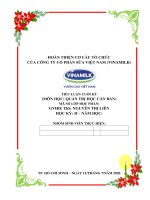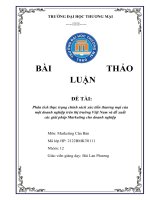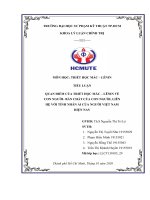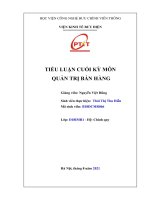Luận cuối kỳ mar căn bản
Bạn đang xem bản rút gọn của tài liệu. Xem và tải ngay bản đầy đủ của tài liệu tại đây (2.29 MB, 24 trang )
UNIVERSITY OF ECONOMICS HO CHI MINH CITY
DEPARTMENT OF INTERNATIONAL BUSINESS AND MARKETING
INDIVIDUAL FINAL EXAM REPORT
ANALYZE THE OBSTACLES AND DIFFICULTIES WHEN IMPLEMENTING
THE PUSH AND PULL MARKETING STRATEGY WITH EXAMPLE
INSTRUCTOR: MR. TRAN MAI DONG
CLASS: MR002 – K48
CLASS MODULE: 23C1MAR50300110
STUDENT NAME: HUYNH NGOC SAN SAN
STUDENT NUMBER: 31221023103
HO CHI MINH CITY, OCTOBER 2023
INTRODUCTION
In these days and ages, when the market is becoming increasingly competitive, businesses are
constantly grasping and updating the latest trends to create advantages. And one of the means to
help them approach the market and act as a bridge between the market and the business is
Marketing activities. From the view of Philip Kotler – an American professor who is widely
considered as the “father” of Marketing, the definition of Marketing can be understood as:
“Marketing is the process by which individuals or groups achieve all what they want through the
process of creating, offering and freely exchanging the values of products and services.
(Marketing is the science and art of exploring, creating, and delivering value to satisfy the needs
of a target market at a profit).
Therefore, in order to exist and develop, businesses not only have to focus on developing the best
products in accordance to the tastes of customers but also marketing campaigns and branding the
products. As a result, it helps to build a name for the company and ensure the sales of the
products, leading to the company’s overall success
Not all businesses share the same strategies, each company will have its own strengths and
weaknesses, and from there, offer different marketing strategies to suit their goals and potential.
One of the most commonly used strategies are the Push and Pull strategies. This essay will
concentrate on the analysis of Push and Pull strategies and give examples.
2
TABLE OF CONTENTS
Contents
INTRODUCTION...........................................................................................................................2
TABLE OF CONTENTS................................................................................................................3
A. Basis of Push and Pull marketing strategies...............................................................................4
I. Push marketing strategy............................................................................................................5
1.1 Definition............................................................................................................................5
1.2 When to use........................................................................................................................6
1.3 Strengths.............................................................................................................................6
1.4 Weaknesses........................................................................................................................6
2. Pull marketing strategy............................................................................................................7
2.1 Definition............................................................................................................................7
2.2 When to use........................................................................................................................8
2.3 Strengths.............................................................................................................................8
2.4 Weaknesses........................................................................................................................9
II. Comparison between Push and Pull strategies......................................................................10
III. Which one is better, Push or Pull?.......................................................................................11
B. Examples of Push and Pull marketing strategies......................................................................12
I. Unspecific examples...............................................................................................................12
1.1 Push Marketing strategy...................................................................................................12
1.2 Pull Marketing strategy....................................................................................................13
II. Specific examples of real-life brands using Push and/or Pull Marketing strategies: Nike. . .14
1.1 Brief introduction of Nike................................................................................................14
1.2 Push Marketing strategy used by Nike.............................................................................15
1.3 Pull Marketing strategy used by Nike..............................................................................19
C. Conclusion................................................................................................................................23
REFERENCES..............................................................................................................................24
3
A. Basis of Push and Pull marketing strategies
Picture 1 Push and Pull marketing activities
(Source: />Before diving into the analysis, we need to understand the nature of push and pull marketing on
how they work and how they differ. Overall, these two strategies originated from Logistics and
Supply chain management, and are also very effectively applicable to the Marketing industry.
When translated word by word, push and pull are two physical actions which respectively mean
to bring something away or close to the subject. In the world of Marketing, in short, push
marketing is a strategy where businesses actively bring a product to consumers even though they
don't need to find it. Meanwhile, pull marketing is when businesses are trying to create
campaigns to attract consumers to products they are actively needing. And the following section
will analyze in more detail.
4
I. Push marketing strategy
Picture 2 Illustration for “Push”
(Source: />
1.1 Definition
A Push Marketing/outbound marketing strategy is to "push" goods from manufacturers or service
providers to intermediaries, focusing on wholesale distribution, intermediaries or sellers. With
this strategy, companies are promoting their product to targeted customers which haven’t been
aware of the products yet and actually wanting them to respond about the products. Additionally,
this directly involves targeting a customer through the act of advertisement with a wide variety
of possible Marketing platforms. What the manufacturers do is that they create active promotion
of their products through physical and digital channels so that the consumers have the
encouragement to become increasingly interested and decide to buy them immediately. So, it
simply creates a demand for intermediaries to import goods from distribution businesses to meet
this emerging trend of demands. Goods will be distributed to intermediaries and from there to the
customers.
Push Marketing is often used to transmit information about a product to consumers, to attract
attention, create need, stimulate the desire to have the product/service right away in the mind of
5
the customer. And when there is a need, customers will look to intermediaries (agents,
distributors) to buy that product or service.
1.2 When to use
When a new product or service is launching, businesses are often encountered pushing their
product recognition through means of advertisements to ensure that customers can vividly see it
and of course get attracted by them.
-> Increasing customers’ awareness about the label.
There are some more situations that Push Marketing tactic can prove its effectiveness (1)
-
Newly-established businesses/online websites
-
New products/services which customers haven’t been aware of
-
Trying to compete against dominant competitors
-
Special events, days which attracts a lot of customers like Christmas, Black Friday, Tet
holiday
1.3 Strengths
Through the use of Push strategy, it will most likely give quick results and a substantial increase
in the sales with the information of the product being propagated more widely to the number of
potential customers, encouraging them to buy and experience themselves. Moreover, the
promotion of physical advertising campaigns can quickly attract the eyes of the majority of
customers, who will choose you and your products over your competitors’...
1.4 Weaknesses
Although it can guarantee a strong increase in sales, the biggest drawback of the Push tactic is
that it costs too much money on campaigns to attract customers. Also, despite yielding quick
results, these campaigns are often short-term and can be unreliable in building an empire of loyal
fans because the advertisements appear almost exclusively once and make customers have
immediate needs then forget about it sooner or after. (2)
6
In terms of advertisements, as a traditional approach, companies often choose a number of ways
to promote products such as vivid physical images through flyers, banners or direct mail about
the products to customers or in the form of pop-up ads on social networking sites and websites.
These types of advertisements are often annoying for customers and they tend to choose to
ignore them, as a result, only attract a few who are really interested in the product.
2. Pull marketing strategy
Picture 3 Illustration for “Pull”
(Source: />
2.1 Definition
A Pull Marketing/inbound marketing strategy involves targeting customers who already have a
prior knowledge of your company's products and are interested in them. Similar to Push
Marketing, it is using advertising methods but with a different purpose is to let customers find
out about the products by advertising in a more subtle way instead of pushing out a large number
of annoying commercials in front of their computer screen and in real life. With the development
of today's technology, people often choose to do online shopping through a series of online
social platforms. Before buying an item, people often think carefully and surf the web to watch
promotional videos promoting the products, online reviews or ask people who have experienced
them to make a buying decision. That way, brands are applying a Pull strategy to create an
7
invisible force that pulls customers through those sales channels because then customers already
know about your product and actively learn about it. Through the use of Pull Marketing strategy,
businesses are able to generate more interest and demand for a product/service, targeting
customers who are already familiar with the brands, to further increase brand loyalty.
So, Pull Marketing is basically the opposite of Push Marketing. This marketing strategy “pulls”
customers towards your objectives, maybe about a product/service or the websites themselves. It
is like reinforcing your customers’ awareness towards a product/service, which can only be done
if consumers are well-known of your brands.
2.2 When to use
As Pull Marketing strategy aims at users who are actively approaching the products, it is best
used to enhance the loyalty of the customers.
There are some circumstances that Pull Marketing strategy is effectively executed (3):
-
For returned customers or improving existing loyalty
-
Maintaining dominance in a specific area of the market
-
Bringing traffic to commercial websites
-
Enhancing recognition and trust in the brands
2.3 Strengths
For experienced marketers with a deep understanding of the industry and high visibility, using
the Pull strategy will bring them the greatest benefit with the application of advertisements,
thereby leading customers to purchase and cleverly trick them into thinking that it's what they
discover by themselves and not through advertising. As a consequence, businesses can create a
good relationship with customers, helping to increase their predilection for the label which
improves satisfaction and loyalty. In addition, a Pull Marketing approach can operate long-term,
thus improving sales and revenue without too big of a price tag spent on advertisements.
8
2.4 Weaknesses
Despite the long-term effect in the industry, Pull Marketing also has some critical disadvantages.
One of them is in the process of making the advertisements. This process can be harsh and timeconsuming because it is extremely difficult to propose a campaign that is suitable for the
customers’ liking. And that is not all, even when businesses succeed in creating good marketing
content for the Pull strategy, not like the Push strategy, the results and beneficial value will not
appear immediately and it is definitely regarded as a boundless, ongoing process that requires
much patience and consistency. (2) Moreover, people coming up with this Pull method have to be
extremely knowledgeable of the current market trends followed by consumers and how our
society functions. Without a wide and deep familiarity with the marketing world, it is much
harder to be successful through adapting the Pull Marketing strategy.
.
II. Comparison between Push and Pull strategies
9
TYPES OF STRATEGY
CONCEPT
PUSH(OUTBOUND)
PULL(INBOUND)
Looking for unaware
Looking for customers who
customers
have already prospects and
interest
DIRECTION
Directing intermediaries
Directing end users/consumers
ACTIVITIES
Pushing products’ information
Pulling customers to make
to customers
them actively search for the
product
INITIATORS
The brands themselves
The customers desiring the
products
FINAL TARGET
Boosting sales
Enhancing loyalty
COST
Mostly expensive
Inexpensive
GOALS
Short-term
Long-term
III. Which one is better, Push or Pull?
Picture 4 Illustration for both Push and Pull
(Source: />10
Between the two approaches of marketing, it really depends on the situations for marketers to
decide on the best one to use. The techniques used will vary on the outcome they seek. But, with
the emergence of today's technology and the fact that many people consider push marketing to be
a form of conventional marketing strategy, many people gradually switch to using the Pull
strategy because Pull tactic does not bombard users with a series of pop-up ads like the Push one
but in a more subtle way. On the other hand, Push Marketing is very important at the opening
stage when you have not built a title, and the top priority is to quickly attract a stable customer
base, and then develop a Pull strategy in the subsequent steps when customers are familiar with
the appearance of the label.
As follows, although there is a slight difference in the actual operation, Push and Pull always
operate in tandem. And now most businesses use both Push and Pull tactics Most newly
established brands have difficulty using Pull, so they use Push first. Once the development is
stable, they will change to using Pull so that they can have a long-term development platform. In
conclusion, both push and pull strategies have their advantages and disadvantages. Each business
has its own unique characteristics (4), so it is those businesses who will decide for themselves the
most appropriate strategy and of course, it is best to use both in balance to succeed in marketing.
B. Examples of Push and Pull marketing strategies
I. Unspecific examples
1.1 Push Marketing strategy
Picture 5 Banners can be seen in many ways
11
(Source: />Push Marketing strategy has many implementations. For instance, if you ever come across a
display of colorful commercials on a website or upon entering some apps, you will realize that
those businesses are using the Push strategy by targeting you with a series of eye-catching
banners, not only online but also in real life in the form of flyers. Sometimes, you will see some
annoying messages or emails directly sent to you to inform you about a newly launched product.
One of the most commonly seen examples of Push Marketing is in the mall or the supermarket.
You will encounter some salespeople introducing their products and handing out small portions
for you to try them out and then persuade you into buying things you don’t even know about or
even demand for.
1.2 Pull Marketing strategy
Picture 6 Illustration for SEO (Search Engine Optimization)
(Source: />As Pull Marketing strategy is more of a contemporary style, it uses some modern tools to
facilitate customers’ experience. And the most well-known of all is SEO (Search Engine
Optimization), which is the process of enhancing brands’ websites through various practices
modifying the algorithms to position them to the top results in search engines like Google, Bing,
Safari... Better visibility of your pages will attract existing customers, leading to more attention
attracted and customers’ interest.(5) Furthermore, nowadays, Gen Z often immerse themselves in
the world of short videos on TikTok, Facebook, Instagram or YouTube and also love to do
12
online shopping with apps like Shopee, Lazada... Through these platforms, interesting contents
can be produced to attract interactions and at the same time spread words about the products.
II. Specific examples of real-life brands using Push and/or Pull Marketing
strategies: Nike
Picture 7 Logo of Nike
(Source: />
1.1 Brief introduction of Nike
Nike was founded in 1964 in Oregon with the first name as Blue Ribbon Sports and officially
changed its name to Nike in 1972. Nike is a sportswear company that is very popular to
consumers nationwide, accounting for 62% of the global market share and presenting in more
than 170 countries. Additionally, Nike is valued at around $29.6 billion and is the most valuable
brand in the sporting goods business.
Nike's field of activity includes: design, development, production, promotion and sales of sports
footwear, clothing, accessories, equipment and services. The company has over 700 shops
around the world and has offices located in 45 countries outside the United States. Most of its
factories are located in Southeast Asia including China, Indonesia, Taiwan, India, Vietnam,
Thailand, Philippines, Pakistan, and Malaysia.
13
Despite the fact that Nike is simply just a company that sells sportswear, their campaigns are
known around the world for their meaningful messages and activities that help the community.
Their priorities include promoting diversity, equity and inclusion for all. In addition, they also
promote the development of sustainable materials to have a better impact on the environment.
With the iconic slogan of “Just do it”, they play a big role in bringing today's generation together
through sport and active lifestyle, for a better tomorrow. (6)
1.2 Push Marketing strategy used by Nike
Picture 8 Nike 3D art billboard in Japan
(Source: />By applying the Push strategy, Nike creates ads and designs eye-catching billboards to attract
customers, typically like the image of a 3D art billboard shoe in Japan. And of course, Nike
reaches its target market by pushing its message at consumers via TV, banners, billboards by
placing them in media publications such as magazines and newspapers.(7) Another example is
that Nike uses is that they distribute their products to many retail stores (for example, in
Vietnam, we have a Nike store in AEON Mall Binh Tan at No.01, street 17A, Quarter 11, Binh
Tri Dong B Ward, Binh Tan Dist., HCMC, and many more) which boosts the visibility and
availability of the product.
14
Picture 9 Nike retail shop in AEON Mall Binh Tan, HCMC
(Source: />
Picture 10 Nike’s six stories retail store in NYC
(Source: />
15
Picture 11 Largest Nike store in the Middle East opened in Dubai Mall
(Source: />Regarding information of their current retail estate, it can be clearly observed that Nike offered a
diverse range of stores, thus personalizing, customizing, and tailoring even more to their
customer base, driven by many analyses of their customers’ deeper insights like their patterns of
doing online shopping, their habits of using apps and so on. (8)
16
Picture 12 Nike’s billboard features members of the USA Women Soccer team in 2019
(Source: />
Picture 13 Nike England kit campaign poster in Manchester
(Source: />
17
Utilizing the Push strategy, Nike were pushing out many quality advertisements through the form
of banners, billboards in the public nationwide. With these ads, Nike has been successful in
imparting emotion, inclusion, advocacy and timeliness through encouraging, heartfelt, multipurposed messages. (9) A simple message can go a long way and positively impact their
consumers, thus enhancing their sales.
1.3 Pull Marketing strategy used by Nike
Pull Marketing strategy involves customers discovering about the products themselves. In that
case, Nike offers a possibility for users to receive emails informing the company's latest
merchandise. The website also leaves other links for users to click on and be redirected to Nike’s
social media including YouTube, Instagram, Facebook, Twitter... (10)
Picture 14 Signing up to receive email from Nike
(Source: />18
Picture 15 More information about Nike and Nike’s social media (right hand corner)
(Source: />
Picture 16 The latest products of Nike showed on the website
(Source: />
19
They also create lots of apps to facilitate customers’ different demands. In order to receive more
information about the brands, the customers have to download several apps through their
smartphones developed by Nike.
Picture 17 Nike’s shopping app
(Source: AppStore)
Picture 18 Nike’s app
(Source: />20









